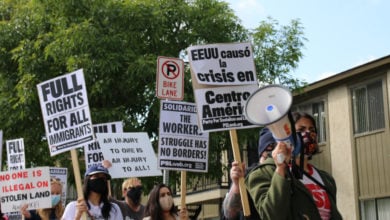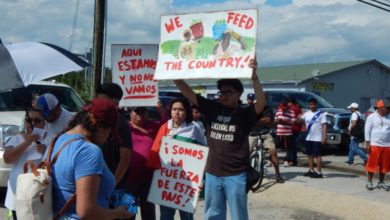Immigrant rights activists in San Antonio held a vigil for over 50 migrants who were discovered dead and dying in the back of an 18-wheeler. The outpouring of grief comes on the heels of the massacre in nearby Uvalde, with working-class Latino communities in south Texas suffering immensely from capitalism’s worst crises and policies.
Sorrow and anger: ‘Everyone in power is an accomplice‘
On the evening of June 28, a worker in San Antonio heard cries for help coming from the trailer of an abandoned truck. Inside were dozens of people: deceased or with severe heat injuries from being trapped without air conditioning or water in the triple digit weather of South Texas. As of this writing, 53 people have died with another 11 continuing to receive medical treatment. The victims of this tragedy are from Mexico, Honduras, Guatemala and El Salvador.
Community groups came together the following day to hold a vigil for the victims. While politicians were trading barbs and placing blame on their political opponents, immigrant rights activists in San Antonio, still reeling from the mass shooting at Robb Elementary School in nearby Uvalde, organized the vigil “to pay tribute to the 50 lives lost and survivors … as well as loved ones impacted by” the tragedy. Organized by the immigrant rights coalition SA Stands and Texas Organizing Project, the vigil was intended to offer community members the “opportunity to grieve, share support, and express sorrow.”
In a surreal twist, the vigil on Tuesday took place during a downpour and cold front which broke a months-long heat wave resulting in the hottest May and June in recorded history.
San Antonio resident Debbie Ponce, who works with and advocates on behalf of detained migrants, spoke at the event:
“This is personal to a lot of us, my coworkers, people that I work with every day. I’ve seen this happen and I know that it didn’t have to happen if we had a better way to allow people to enter safely. If we had a better way for Brown and Black people to get to safety, they wouldn’t go through these desperate measures. There were entire families in that truck.”
Carlos Eduardo Espina, an organizer for immigrant rights, expressed the futility of relying upon the corporate parties for leadership:
“Every time there’s a tragedy like this, we pretend like it’s something unbelievable, like ‘we can’t believe that this happened.’ But if you don’t believe this happens, then you don’t know how immigration works in this country. Because this happens every day … It’s a reality. Why is it a reality? Because in our countries we have governments that are corrupt, that are useless … [And in the United States,] we always tend to protect one political party, but the reality is neither political party gives a shit about immigrants. That’s a reality … Everyone who’s in power here in the United States is an accomplice to what’s going on.”
Others recalled the brutal experiences they or family members went through during border crossings, while a trio of children described giving assistance to migrants who travel on trains that run next to their house. Speakers illustrated the failure of an immigration policy based on the criminalization of border crossing and the militarization of the border. Far from discouraging the attempts to seek more stable political and/or economic conditions in the United States, these policies merely make border crossings much more perilous and pushes migrants into a range of deeply dangerous situations.
An altar was built at the site the trailer was discovered in remembrance of those who perished there days earlier. Offerings from the community including candles, bottles of water, flowers and flags of the origin countries, as well as clothing of some of the victims.
While Monday’s catastrophic loss of life is the worst in recent years, it is far from the first, with similar tragedies in 2003 and 2017. This is in addition to the hundreds who perish each year in border crossings on foot or by attempting to swim across the Rio Grande, which delineates the U.S.-Mexico border from El Paso to the Gulf of Mexico.
Migrant suffering is by cruel, imperialist economic design
Officials are quick to pin accountability on the “human smuggling” or “human trafficking” operations, which transport migrants across the border. Four have been arrested in connection to the deaths in the abandoned tractor-trailer.
Border Patrol’s sudden concern for “smuggling” and “trafficking” are a smokescreen for their actions in south Texas, providing a humanitarian veneer to racist, dehumanizing policies. These narratives are convenient in maintaining migration as a criminal activity, justifying the outsized funding and violence of the U.S. Border Patrol, Immigration and Customs Enforcement, National Guard, and other repressive agencies along the border. But, like the decades-long “War on Drugs,” border policies largely perpetuate racist state violence, disruption of families, bigoted narratives, and mass incarceration while failing to address the political and economic root causes of migration in the least.
Migration is a fundamentally human activity, not a criminal act. The criminalization of migrants in the United States is by economic, imperialist and bipartisan design.
As defined first in the Monroe Doctrine in 1823, the United States has insisted that the countries of Latin America are its “backyard,” and asserts that it has a right to control the land, labor, and resources of the entire hemisphere. This has been violently backed up by over 50 U.S. military “interventions,” dozens of coups, and economic warfare through sanctions, predatory IMF loans and outright theft of assets.
The militarization of the border with Mexico has been a deliberate bipartisan strategy. As the Clinton administration was preparing the North American Free Trade Agreement in 1994, they anticipated that their new economic policies — allowing U.S. corporations to buy up Mexican farmland and industry, enforcing impoverishment and unemployment on both sides of the border — would lead to economic refugees. By the end of the Clinton administration, border patrol funding had almost tripled from $400 million to $1.1 billion. The Bush years doubled funding again to $2.6 billion and created ICE, the Obama years brought funding to $4.2 billion, and the Trump years increased funding to $4.9 billion — a more than 12-fold increase in less than 30 years.
The NAFTA-era Border Patrol also ushered in the U.S. border policy to this day: “prevention through deterrence.” This means that the U.S. government turns border towns into heavily fortified, hyper-policed fortresses, forcing migrants to cross in more dangerous ways and through more remote areas. At least 650 people died crossing the border in 2021, the highest number on record.
U.S. politicians have no solutions for the violence that their policies have created. They point the blame at each other or at the lowest-level traffickers who take the “last step” across the border. But they cannot point to the root cause of economic suffering and violence in the region: the United States government itself. South Texas is grieving again, as are countless family members across Central America, for the latest victims of the cruelty of U.S. imperialism.





